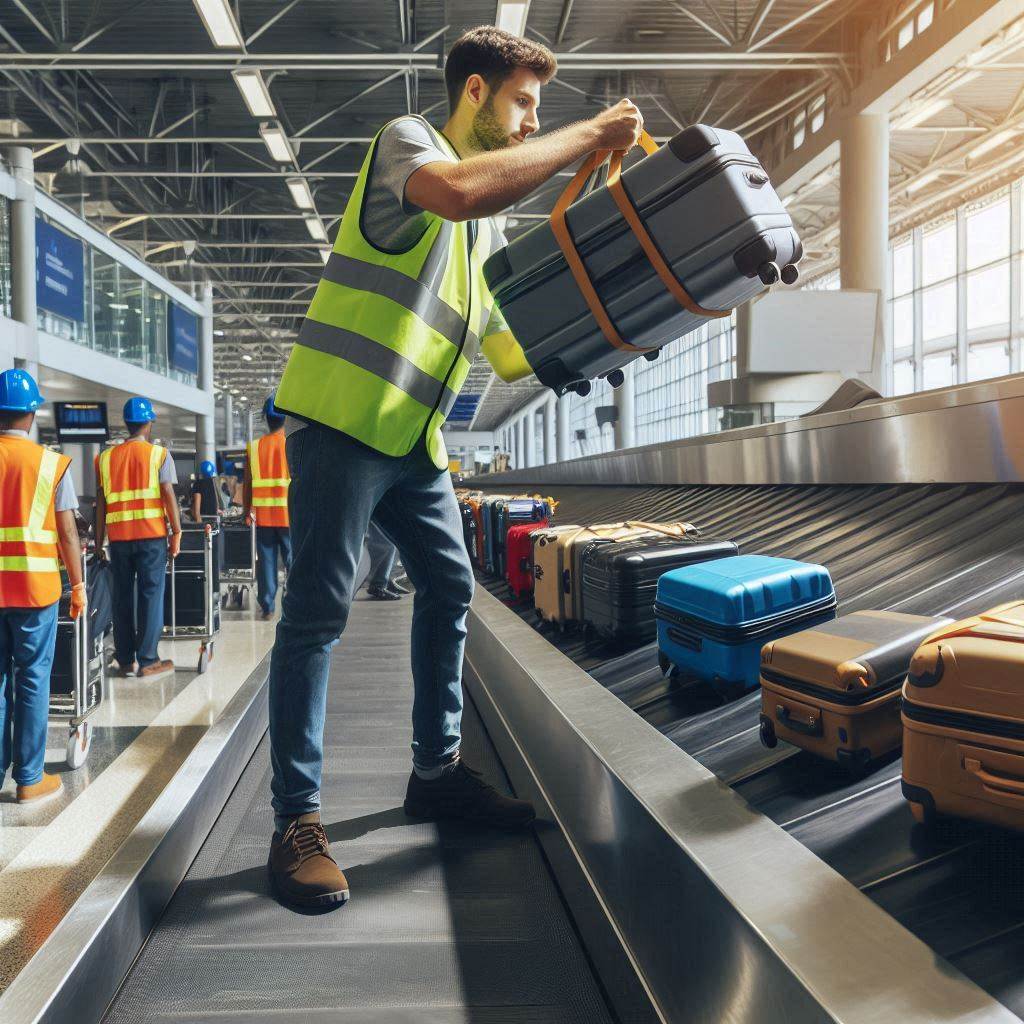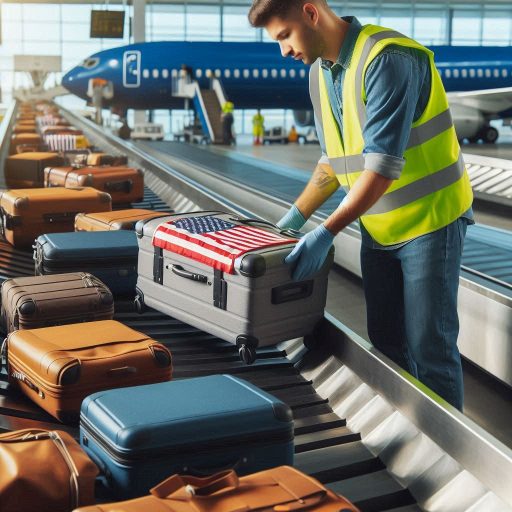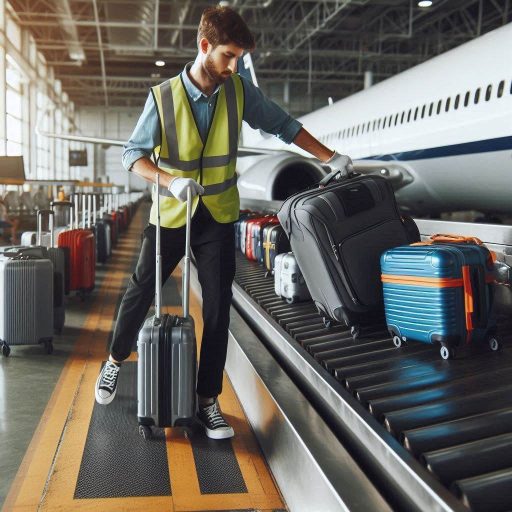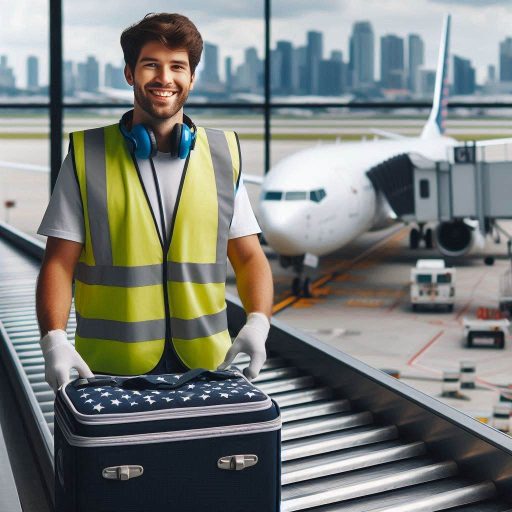Introduction
Baggage handling is a critical function in various industries, including airlines, hotels, and cruise lines.
Efficient handling ensures the safe and timely delivery of luggage to travelers.
In the airline industry, proper baggage management directly affects passenger satisfaction and operational efficiency.
Hotels rely on effective baggage handling to enhance guest experiences, especially during check-in and check-out.
Cruise lines depend on seamless baggage processes to maintain smooth operations at ports.
Using proper tools and equipment is vital for efficient baggage handling.
Specialized carts and tugs streamline the transportation of heavy luggage across airport terminals and docks.
Conveyor belts facilitate the quick movement of bags, reducing handling time and labor.
Scanners and tracking systems help ensure that luggage reaches its correct destination without delays.
Moreover, safety equipment, such as gloves and back supports, protects workers from injuries.
Proper tools enable handlers to work more effectively, minimizing the risk of lost or damaged baggage.
Effective baggage handling is essential in various industries.
Utilizing the right tools and equipment enhances efficiency and improves the overall experience for travelers.
By prioritizing proper resources, companies can ensure smooth operations and customer satisfaction.
Importance of Baggage Handling
The Impact of Efficient Baggage Handling on Customer Satisfaction and Overall Operational Efficiency
Efficient baggage handling directly impacts customer satisfaction in the airline industry.
When luggage is managed promptly, passengers experience fewer delays.
Quick and reliable service creates a positive impression of the airline.
Passengers appreciate knowing their belongings will arrive safely and on time.
Efficient baggage handling also contributes to overall operational efficiency.
When baggage handlers work effectively, they keep flights on schedule.
This punctuality helps airlines maintain their reputation and operational reliability.
Happy passengers often become repeat customers, which benefits the airline financially.
Additionally, smooth baggage handling processes reduce the workload on airport staff.
When luggage is transported quickly, fewer resources are needed for follow-up issues.
This efficiency allows staff to focus on other essential tasks, enhancing overall productivity.
Furthermore, airlines that prioritize efficient baggage handling often enjoy a competitive advantage.
Passengers are more likely to choose airlines known for reliability.
A strong reputation for efficient baggage management can set an airline apart from its competitors.
The Potential Consequences of Mishandling Baggage
Mishandling baggage can lead to several negative consequences.
Delays often occur when luggage is not properly loaded or unloaded.
These delays can disrupt flight schedules and frustrate passengers.
Damaged luggage is another common issue caused by mishandling.
When bags are not handled carefully, they can suffer dents, tears, or broken zippers.
Damaged luggage results in unhappy passengers and additional costs for the airline.
Customer complaints also escalate when baggage is mishandled.
Passengers may express their dissatisfaction through reviews, social media, or direct complaints.
A high volume of complaints can tarnish an airline’s reputation and decrease customer loyalty.
Moreover, mishandling baggage can lead to lost items.
When luggage is misplaced, the airline must spend time and resources locating it.
This situation often results in further frustration for passengers and additional operational challenges.
The financial implications of mishandling baggage can be significant.
Airlines may incur costs related to compensation for lost or damaged luggage.
This financial burden can strain the airline‘s budget and affect profitability.
Training and proper equipment are essential to prevent mishandling.
Airlines must invest in employee training programs to ensure best practices in baggage handling.
Providing the right tools and equipment also helps minimize risks associated with mishandling.
Efficient baggage handling plays a crucial role in customer satisfaction and operational efficiency.
It reduces delays, enhances service quality, and fosters customer loyalty.
Conversely, mishandling baggage leads to negative consequences, such as delays, damages, and customer complaints.
Airlines must prioritize effective baggage handling to maintain a positive reputation and operational success.
By investing in training and equipment, airlines can ensure that baggage handling contributes to a seamless travel experience for all passengers.
Read: Understanding Pet Grooming Safety Standards
Types of Baggage Handling Tools
Essential Tools Used in Baggage Handling
Baggage handling relies on several essential tools and equipment.
Each tool plays a crucial role in ensuring efficient and smooth operations.
Here, we will explore key tools used in baggage handling and their functions.
Luggage Carts
Luggage carts are vital for transporting bags between the terminal and aircraft.
Handlers use these carts to move multiple pieces of luggage at once.
This reduces the physical strain on workers and speeds up the loading process.
Carts are designed to be sturdy and lightweight.
They can hold heavy bags without compromising stability.
Proper maintenance ensures that the carts remain functional and safe for use.
Baggage Conveyor Belts
Baggage conveyor belts streamline the movement of luggage within the airport.
These belts transport bags from check-in counters to the loading area.
They save time and labor while minimizing the risk of mishandling.
Handlers place bags on the conveyor belt for automated transport.
This system reduces the need for manual lifting and moving.
It also helps keep baggage organized, which is essential during busy travel periods.
Baggage Scanners
Baggage scanners are essential for security and safety in airports.
These devices allow security personnel to inspect luggage without opening it.
Scanners help identify prohibited items, ensuring passenger safety.
Handlers work closely with security teams to monitor scanned bags.
They assist in retrieving bags flagged for further inspection.
This collaboration enhances security measures while maintaining efficient baggage flow.
RFID Tags
Radio Frequency Identification (RFID) tags improve tracking and management of luggage.
Each bag receives a unique RFID tag, which helps monitor its location throughout the airport.
This technology significantly reduces the chances of lost luggage.
Handlers scan RFID tags at various points during the baggage process.
This scanning updates the bag‘s status in real-time, allowing for efficient tracking.
Passengers can also track their luggage via airline apps, providing peace of mind.
Functions of Each Tool and Contribution to Smooth Baggage Handling Operations
Each tool plays a specific role in enhancing baggage handling efficiency.
Luggage carts reduce physical labor, allowing handlers to transport multiple bags quickly.
This capability helps keep operations moving smoothly, especially during peak travel times.
Baggage conveyor belts automate the transport process, minimizing delays.
They ensure bags arrive at their destinations on time, contributing to overall operational efficiency.
This system also reduces the likelihood of human error during handling.
Baggage scanners improve security while maintaining efficiency.
They allow for quick inspections, ensuring that bags can move through security checks rapidly.
This efficiency is crucial for preventing long wait times at checkpoints.
RFID tags enhance baggage tracking, reducing the incidence of lost luggage.
This technology provides real-time updates, improving communication between handlers and passengers.
By minimizing lost bags, airlines improve customer satisfaction and trust.
The tools and equipment used in baggage handling are essential for smooth operations.
Luggage carts, baggage conveyor belts, baggage scanners, and RFID tags all contribute to efficiency and security.
These tools enhance the overall travel experience for passengers and streamline operations for airlines.
As technology continues to evolve, baggage handling will likely become even more efficient, ensuring timely and secure delivery of luggage.
Read: Understanding Nail Disorders: A Technician‘s Guide
Equipment for Load Planning
Importance of Load Planning Equipment
Load planning equipment is crucial for efficient baggage handling at airports.
Proper load distribution prevents accidents and ensures safe transportation of luggage.
When weight is distributed evenly, it enhances the stability of the aircraft during flight.
Handlers must consider various factors when planning loads, including the type and size of baggage.
Different bags have unique weight distributions, and understanding these helps optimize loading.
Load planning equipment assists in calculating the correct placement of luggage within the cargo hold.
Furthermore, correct load planning minimizes the risk of damage to luggage.
Properly loaded baggage reduces the likelihood of shifting during transport.
This precaution protects both the passengers’ belongings and the aircraft itself.
Additionally, effective load planning can save time during the loading process.
When handlers use load planning tools, they streamline their workflow.
This efficiency allows for quicker turnaround times between flights, enhancing overall airport operations.
Tools for Accurate and Safe Loading of Baggage
Several tools are essential for accurate and safe loading of baggage onto vehicles.
Load planners play a vital role in ensuring weight is distributed evenly.
These devices help handlers determine the best arrangement for different types of luggage.
Weight scales are another important tool in baggage handling.
Handlers use these scales to verify the weight of each bag before loading.
Knowing the weight of luggage ensures compliance with airline regulations and safety standards.
Inaccurate weight measurements can lead to overloaded aircraft, which is dangerous.
Proper use of weight scales helps prevent these risks by ensuring that all bags are within allowable limits.
Load scanners also contribute significantly to safe baggage handling.
These devices scan luggage to identify its dimensions and weight.
Accurate measurements allow handlers to make informed decisions about how to load the baggage efficiently.
Additionally, load scanners help identify any unusual items in luggage.
This capability enhances security and ensures that handlers adhere to safety regulations.
Recognizing potential threats or prohibited items before loading is essential for passenger safety.
Moreover, many airports now utilize advanced software for load planning.
This software can integrate data from load planners, weight scales, and load scanners.
By analyzing this information, handlers can optimize their loading processes further.
In review, load planning equipment is essential for efficient baggage handling.
Proper weight distribution enhances safety and protects passengers’ belongings.
Tools like load planners, weight scales, and load scanners play critical roles in this process.
By using these tools effectively, baggage handlers can ensure safe and efficient loading practices.
Adhering to safety regulations and optimizing workflows ultimately improves overall airport operations.
This commitment to excellence in baggage handling fosters a positive experience for passengers and airlines alike.
Read: How to Deal with Pet Grooming Allergies

Security Screening Equipment
The Necessity of Security Screening Equipment in Baggage Handling
Security screening equipment is essential in baggage handling for ensuring passenger safety.
Tools such as X-ray machines and explosive detection systems play a vital role.
These devices help airports comply with strict aviation regulations designed to protect travelers.
X-ray machines allow security personnel to view the contents of bags without opening them.
This capability speeds up the inspection process while maintaining safety.
Handlers can quickly identify any suspicious items, minimizing delays for passengers.
Explosive detection systems further enhance security measures in baggage handling.
These systems use advanced technology to detect explosive materials hidden within luggage.
By identifying threats before they reach the aircraft, airports significantly reduce the risk of dangerous situations.
Compliance with aviation regulations is critical for maintaining safe travel environments.
Airports must implement rigorous screening procedures to meet legal requirements.
Using security screening equipment helps ensure that all bags are thoroughly examined before boarding.
Furthermore, passengers often feel more secure knowing that their luggage undergoes thorough screening.
This sense of safety enhances the overall travel experience.
Travelers are likely to have more confidence in airlines that prioritize security measures.
How Security Tools Help Detect Prohibited Items
Security screening tools are crucial for detecting prohibited items in baggage.
These tools identify various dangerous objects that could pose security risks.
Items such as knives, firearms, and explosives must be carefully monitored to prevent incidents.
X-ray machines provide detailed images of luggage contents, highlighting unusual shapes or densities.
Security personnel receive specialized training to interpret these images accurately.
Their expertise enables them to identify potentially dangerous items quickly.
Additionally, explosive detection systems analyze the chemical composition of materials in bags.
These systems can pinpoint traces of explosives, alerting security staff to potential threats.
Early detection helps authorities respond swiftly to any suspicious situations.
Moreover, these security tools contribute to efficient baggage handling operations.
By ensuring that all bags undergo thorough inspections, airports can minimize security breaches.
A streamlined screening process prevents bottlenecks, ensuring timely departures.
Airports also implement regular maintenance and updates for screening equipment.
Keeping machines in optimal condition is essential for accurate results.
Regular inspections and upgrades enhance the reliability of security measures.
Furthermore, collaboration between airport security and baggage handlers is vital.
Open communication helps ensure that all parties understand screening protocols.
This teamwork is essential for maintaining a secure and efficient baggage handling system.
Essentially, security screening equipment is necessary for effective baggage handling.
X-ray machines and explosive detection systems help ensure passenger safety.
By detecting prohibited items, these tools prevent potential security threats in baggage.
Maintaining compliance with aviation regulations reinforces trust in the travel system.
Airports must prioritize the use of advanced security technology to protect travelers.
Ultimately, investing in security screening equipment contributes to safer and more efficient airport operations.
Read: Creating a Comfortable Atmosphere in Your Nail Salon
Uncover the Details: Event Planning Etiquette: Do’s and Don’ts
Baggage Handling Automation
Benefits of Automation in Baggage Handling
Automation significantly improves baggage handling efficiency at airports.
It offers faster processing times for luggage, enhancing the overall passenger experience.
Automated systems can quickly sort and route baggage to the correct destinations.
This speed reduces the time passengers wait for their luggage at baggage claim.
Automation also minimizes human errors during baggage handling.
Manual sorting often leads to misplaced or lost bags.
Automated systems use advanced technology to track and route luggage accurately.
This reliability increases the likelihood that bags arrive safely at their intended destinations.
Increased operational capacity is another major benefit of automation.
Automated systems can process a higher volume of baggage than manual methods.
This increased capacity allows airports to manage more flights without compromising service quality.
As air travel continues to grow, automation helps meet rising demands effectively.
Overall, automation enhances the efficiency and accuracy of baggage handling operations.
These improvements contribute to a more streamlined airport experience for both passengers and staff.
Tools That Streamline the Baggage Handling Process
Several tools and technologies contribute to the automation of baggage handling.
Automated baggage sorting systems are among the most significant advancements.
These systems use conveyor belts and scanners to efficiently sort bags by flight number and destination.
This automation speeds up the sorting process, reducing delays during peak travel times.
Robotic luggage handling devices are another innovative solution.
These robots can transport baggage from the check-in area to the tarmac.
They navigate through the airport using sensors and cameras to avoid obstacles.
This technology minimizes the need for manual labor and enhances safety in the baggage handling process.
Automated check-in kiosks also play a crucial role in streamlining baggage handling.
These kiosks allow passengers to check in their luggage quickly and efficiently.
By automating this process, airlines can reduce waiting times and improve customer satisfaction.
RFID (Radio Frequency Identification) technology further enhances baggage tracking and management.
RFID tags attached to bags allow for real-time tracking throughout the airport.
This technology provides accurate information about the location of each bag.
Baggage handlers can quickly locate and retrieve luggage, minimizing the risk of loss.
Integrated baggage handling systems combine various technologies to create a seamless process.
These systems coordinate all aspects of baggage handling, from check-in to delivery.
By centralizing operations, airports can improve efficiency and reduce errors.
In addition to these technologies, training staff to work alongside automation is essential.
Baggage handlers must understand how to use automated systems effectively.
This training ensures smooth integration of technology into daily operations.
On a final note, automation offers significant benefits in baggage handling, including faster processing, reduced errors, and increased operational capacity.
Transform Your Career Today
Unlock a personalized career strategy that drives real results. Get tailored advice and a roadmap designed just for you.
Start NowTraining and Maintenance of Tools and Equipment
Importance of Regular Training for Staff
Regular training for staff operating baggage handling tools and equipment is crucial.
Proper training ensures staff understand how to use equipment safely and effectively.
When employees know how to operate tools correctly, they minimize the risk of accidents.
Training should cover various aspects of equipment usage.
This includes understanding specific features and functionalities of each tool.
For instance, staff should learn how to safely operate conveyor belts, trolleys, and forklifts.
Familiarity with equipment increases confidence and efficiency in handling baggage.
Additionally, training programs should emphasize safety protocols.
Employees must be aware of potential hazards associated with baggage handling tools.
Knowledge of safety measures helps prevent injuries and accidents in the workplace.
Regular refresher courses can help maintain skill levels over time.
These courses can update staff on new equipment or procedures.
Continuous learning fosters a culture of safety and competence among baggage handlers.
Furthermore, hands-on training sessions provide practical experience.
These sessions allow staff to practice operating equipment in a controlled environment.
Hands-on training enhances confidence and prepares employees for real-life situations.
Significance of Regular Maintenance and Inspection of Tools
Regular maintenance and inspection of baggage handling tools are vital for optimal performance.
Well-maintained equipment operates more efficiently and reduces the risk of breakdowns.
Frequent inspections help identify potential issues before they escalate into major problems.
Establishing a routine maintenance schedule ensures all tools receive necessary care.
Maintenance tasks may include lubricating moving parts, checking for wear and tear, and replacing damaged components.
Keeping equipment in good condition extends its lifespan and improves safety.
Additionally, inspections should be documented to track the condition of tools.
This documentation can help identify patterns in equipment wear.
Understanding these patterns enables staff to anticipate maintenance needs and budget accordingly.
Employees should also be trained to conduct basic inspections.
Teaching staff to identify potential issues can lead to early detection of problems.
Empowering employees to take an active role in equipment care fosters a sense of responsibility.
Moreover, regular maintenance can prevent costly malfunctions.
When tools malfunction, it can lead to delays in baggage handling operations.
These delays can frustrate passengers and impact overall airline efficiency.
Additionally, airlines can incur significant repair costs if equipment malfunctions frequently.
Investing in regular maintenance reduces long-term expenses and enhances operational efficiency.
To sum it up, regular training for staff operating baggage handling tools is essential for safety and efficiency.
Proper training empowers employees to use equipment correctly and recognize hazards.
Simultaneously, regular maintenance and inspection of tools prevent malfunctions and ensure optimal performance.
Establishing maintenance schedules and training staff for inspections fosters a proactive approach to equipment care.
By prioritizing training and maintenance, airlines can improve safety, efficiency, and the overall baggage handling process.
A well-trained team using reliable equipment contributes to a smoother travel experience for passengers.
Conclusion
Baggage handling requires the use of essential tools and equipment for efficiency and safety.
Key tools include baggage carts, conveyor belts, and tugs.
These tools streamline the movement of luggage from check-in to the aircraft.
Additionally, using proper equipment reduces the risk of injuries among baggage handlers.
Investing in the right tools is crucial for maintaining smooth operations.
Quality equipment helps minimize delays and ensures that luggage is processed accurately.
Handlers equipped with effective tools can manage high volumes of baggage, especially during peak travel times.
Businesses in the transportation and hospitality industries should prioritize investing in quality tools and equipment.
Upgrading outdated systems can significantly improve efficiency and reduce operational costs.
High-quality equipment also enhances the overall safety of baggage handling processes, protecting both employees and passengers.
Furthermore, investing in training programs for staff on using these tools effectively is essential.
Proper training maximizes the benefits of new equipment and promotes a culture of safety.
Using the right tools and equipment is vital for efficient baggage handling.
By investing in quality resources, businesses can improve their operations and enhance customer satisfaction.
The benefits of these investments extend beyond immediate efficiency, contributing to long-term success in the industry.
[E-Books for Sale]
The Big Book of 500 High-Paying Jobs in America: Unlock Your Earning Potential
$19.99 • 500 High-Paying Jobs • 330 pages
Explore 500 high-paying jobs in America and learn how to boost your career, earn more, and achieve success!
See All 500 High-Paying Jobs of this E-Book
1001 Professions Without a Degree: High-Paying American Jobs You Can Start Now
$19.99 • 1001 Professions Without a Degree • 174 pages
Discover 1001 high-paying jobs without a degree! Unlock career tips, skills, and success strategies for just $19.99!




